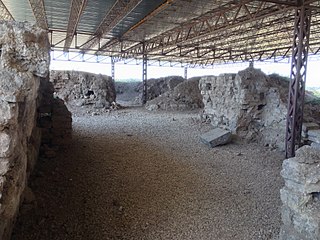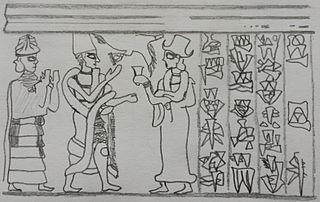Related Research Articles

Yamhad (Yamḫad) was an ancient Semitic-speaking kingdom centered on Ḥalab (Aleppo) in Syria. The kingdom emerged at the end of the 19th century BC and was ruled by the Yamhad dynasty, who counted on both military and diplomacy to expand their realm. From the beginning of its establishment, the kingdom withstood the aggressions of its neighbors Mari, Qatna and the Old Assyrian Empire, and was turned into the most powerful Syrian kingdom of its era through the actions of its king Yarim-Lim I. By the middle of the 18th century BC, most of Syria minus the south came under the authority of Yamhad, either as a direct possession or through vassalage, and for nearly a century and a half, Yamhad dominated northern, northwestern and eastern Syria, and had influence over small kingdoms in Mesopotamia at the borders of Elam. The kingdom was eventually destroyed by the Hittites, then annexed by Mitanni in the 16th century BC.

Alalakh is an ancient archaeological site approximately 20 kilometres (12 mi) northeast of Antakya in what is now Turkey's Hatay Province. It flourished as an urban settlement in the Middle and Late Bronze Age, c. 2000-1200 BC. The city contained palaces, temples, private houses and fortifications. The remains of Alalakh have formed an extensive mound covering around 22 hectares. In the Late Bronze Age, Alalakh was the capital of the local kingdom of Mukiš.

Enikő Bollobás is a Hungarian literary scholar, professor at the School of English and American Studies of the Faculty of Humanities of Eötvös Loránd University, Budapest. She is a corresponding member of the Hungarian Academy of Sciences.

In geometry, circle packing is the study of the arrangement of circles on a given surface such that no overlapping occurs and so that no circle can be enlarged without creating an overlap. The associated packing density, η, of an arrangement is the proportion of the surface covered by the circles. Generalisations can be made to higher dimensions – this is called sphere packing, which usually deals only with identical spheres.
Hammurabi I is the third attested king of Yamhad (Halab).

Abba-El I was the fourth great king of Yamhad (Halab), succeeding his father Hammurabi I.

Yarim-Lim II was the king of Yamhad succeeding his father Abba-El I.

Niqmi-Epuḫ, also given as Niqmepa was the king of Yamḫad (Halab) succeeding his father Yarim-Lim II.
Irkabtum was the king of Yamhad (Halab), succeeding his father Niqmi-Epuh.
Yarim-Lim III was the king of Yamhad (Halab) succeeding Hammurabi II.
Hammurabi II was an obscure king of Yamhad (Halab), probably reigning after Irkabtum.
Sarra-El also written Šarran was a prince of Yamhad who might have regained the throne after the assassination of the Hittite king Mursili I.

Abba-El II was the king of Halab who reigned after the withdrawal of the Hittites.
Ilim-Ilimma I was the king of Yamhad succeeding his father Abba-El II.
Hammurabi III was the king of Yamhad (Halab) succeeding Yarim-Lim III.
Hassum was a Hurrian city-state, located in southern Turkey most probably on the Euphrates river north of Carchemish.

Yarim-Lim was a king of Alalakh and son of Hammurabi I of Yamhad. He was granted the city of Alalakh by his brother Abba-El I of Yamhad and started a cadet branch of the Yamhadite dynasty that lasted until the conquest of Alalakh by the Hittite king Hattusili I.

The Yamhad dynasty was an ancient Amorite royal family founded in c. 1810 BC by Sumu-Epuh of Yamhad who had his capital in the city of Aleppo. Started as a local dynasty, the family expanded its influence through the actions of its energetic ruler Yarim-Lim I who turned it into the most influential family in the Levant through both diplomatic and military tools. At its height the dynasty controlled most of northern Syria and the modern Turkish province of Hatay with a cadet branch ruling in the city of Alalakh.
István Andrássy was a Hungarian nematologist. Starting with his first publication in 1952 on the nematode fauna of Mount Bükk, over his dissertation in 1973 on the evolution of nematodes to his last days he was a very prolific scientist, publishing more than 200 manuscripts, chapters and books on the class of Nematoda. He described 530 taxa of nematodes and at least 60 nematode taxa are named after him, which shows the huge respect he had in the nematologists world.
The Somogyvár-Vinkovci culture was an Early Bronze Age archaeological culture in the Central Danube Carpathian Region.
References
- ↑ Goldman, Edward A. (1978-12-31). Jews in a Free Society: Challenges and Opportunities. ISD LLC. ISBN 978-0-87820-472-4.
- ↑ Klengel, Horst (1992-03-20). Syria 3000 to 300 B.C.: A Handbook of Political History. Wiley. ISBN 978-3-05-001820-1.
- ↑ Orientalia: Vol. 38. Gregorian Biblical BookShop.
- ↑ Giacumakis, George (1970). The Akkadian of Alalah. Mouton.
- ↑ Tudományegyetem, Eötvös Loránd (1979). Annales Universitatis Scientiarum Budapestinensis de Rolando Eötvös Nominatae: Sectio classica. Universitatis Scientiarum Budapestinensis de Rolando Eötvös nominatae.